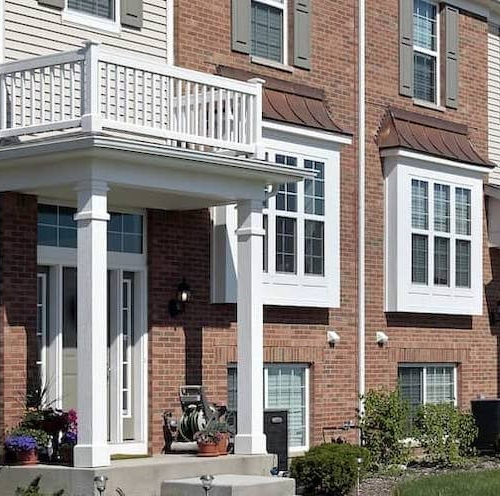New York CEMA loans: Everything you need to know
Jun 10, 2025
•5-minute read

Homeowners in New York state who refinance their mortgage can significantly reduce their mortgage tax bill with a CEMA loan, which consolidates their current mortgage and the new loan. Learn more about how CEMA loans work and if one can save you money when refinancing.
Key takeaways:
- A CEMA loan allows owners of homes in New York state to consolidate their loans when refinancing to reduce their mortgage tax bill.
- CEMA loans require your original lender to transfer your loan to your new lender and consolidate it with your new loan into a single mortgage.
- CEMA loans require you to pay fees to your lenders and usually take longer than a traditional refinance.
What is a CEMA loan?
The state of New York charges a mortgage tax on new mortgages, which applies whether a new loan is used to buy or refinance a home. Some New York municipalities charge their own mortgage tax in addition to the state tax.
The mortgage tax is levied on the principal of any new mortgage. The typical rate is 1% – 2% of the loan amount. If you’re taking out a mortgage for $500,000, the tax would be $5,000 – $10,000.
To reduce this tax, you can get a consolidation, extension, and modification agreement loan, commonly known as a CEMA loan. A CEMA loan is an agreement between the lender of your current mortgage and the lender of your new mortgage to consolidate your old and new loan into a single mortgage. The original loan is reassigned to the new lender, and you pay mortgage tax only on the difference between your original loan amount and your new loan amount.
Say you want to refinance your mortgage with a balance of $550,000 by taking out a new loan for $750,000. A CEMA loan would allow you to pay mortgage tax only on the $200,000 difference instead of the full $750,000.
CEMA loans are only for homes being refinanced in the state of New York. There are some exceptions where you can use a CEMA loan to buy a home.
What are the fees associated with CEMA loans in New York?
Lenders typically charge processing fees and legal or attorney fees to ensure the loan transfer goes smoothly. The amount you pay will differ depending on the lender, but you’ll most likely need to pay fees to both your current and new lender. Some may also charge recording fees to legally record your new loan with New York and local government agencies.
On average, you can expect to pay around $500 to $750 for processing fees per lender and $500 in recording fees for a total of $1,500 to $2,000.
These fees don’t include up-front closing costs that you’ll need to pay for a refinance.
How long does it take to get approved for a CEMA loan?
CEMA loans take longer to process than a traditional refinance. Lenders need to work together to send, receive and process documentation, as well as ensure the final closing complies with New York law.
It could take 30 – 60 business days for your current lender to send all required documents to your new one. All in all, it could take about 75 days to close on a CEMA loan.
What is the difference between a CEMA and a non-CEMA loan?
CEMA loans may come with longer processing times and several more fees, but in most cases, the mortgage tax savings offset some of these negatives.
For example, say your current mortgage balance is $650,000, and you want to refinance to a $725,000 mortgage. Your home is in Yonkers, which has a 1.8% mortgage recording tax. Instead of paying $13,050 in taxes through a traditional refinance, you’ll pay $1,350 instead. Even with CEMA-related fees of about $1,500, you’re still saving a significant amount.
CEMA loans vs. HELOCs
A CEMA loan replaces your current home loan with a new one. You can use a CEMA loan to get a cash-out refinance, where your new loan is based on your home’s current value. In the consolidation, you pay off your current loan and keep the difference in cash. You repay the equity you’ve borrowed as part of your new loan.
A home equity line of credit, or HELOC, is a second mortgage that you pay alongside your primary mortgage. A HELOC uses your equity to establish a line of credit. You can borrow from the HELOC as needed during the draw period, making payments on what you borrow. In the repayment period, you can no longer draw from the HELOC and must make regular payments to retire the balance and interest.
Both allow you to borrow your equity, though how you receive and repay the loan is different.
Rocket Mortgage® does not offer HELOCs, but we’ll explain them to help you understand all your loan options.
Pros and cons of CEMA loans
As with all types of loans, there are advantages and disadvantages to CEMA loans.
Pros
- Lower mortgage tax payments: You may be able to save a significant amount on mortgage tax since you’re only taxed on the difference between your current principal balance and your new loan amount.
- Save on loan costs: Just like with a traditional mortgage refinance, a CEMA loan allows you to swap out your current loan terms for a new loan with better terms, such as a lower interest rate, to save money.
Cons
- Lender fees: You need to pay fees to get a CEMA loan. Fees average $1,500 – $2,000, so you need to consider this cost when deciding whether a CEMA loan saves you more than a traditional refinance.
- Long processing time: A CEMA loan may be more complex than a traditional refinance, as the original lender needs to work with the new lender to review documents and ensure all documentation is accurate. While a regular refinance takes an average of 30 days, a CEMA loan takes, on average, 75 days to close.
When is a CEMA refinance the best choice?
A CEMA refinance may be better if your main goal is to save on mortgage recording tax as a New York homeowner. The bigger the difference between your original loan amount and your remaining principal balance, the more you could save.
Before you sign the dotted line, make sure the potential savings are worth it. For example, if the CEMA fees you need to pay are the same or more than the amount you’ll save on mortgage tax, the longer wait and additional paperwork for a CEMA may not be worth it.
FAQ
Here are answers to common questions about New York CEMA loans.
Where do I get a CEMA loan?
CEMA loans are available only for properties in New York state. Not all mortgage lenders in New York offer CEMA loans. If your current lender offers them and you can qualify for a lower rate, you could save time and fees by working with them on a refinance.
Can I use a CEMA loan to refinance a co-op?
Co-ops in New York count as personal property. Since you own individual shares in a co-op, these properties aren’t considered property, so you won’t qualify for a CEMA loan and are not required to pay mortgage tax.
The bottom line: CEMA loans could save you money
If you’ve been thinking about refinancing your home in New York, CEMA loans may be worth taking a look at. Although there may be some more hurdles involved, you could save thousands by reducing the amount of mortgage recording tax you’ll need to pay.
Whether you're looking for a CEMA lender or another mortgage solution, consider Rocket Mortgage® for your mortgage refinancing needs.

Victoria Araj
Victoria Araj is a Team Leader for Rocket Mortgage and held roles in mortgage banking, public relations and more in her 19+ years with the company. She holds a bachelor’s degree in journalism with an emphasis in political science from Michigan State University, and a master’s degree in public administration from the University of Michigan.
Related resources

7-minute read
Non-owner-occupied mortgage rates: What investors need to know
Explore non-owner-occupied mortgage rates, key requirements, and financing options for your investment property goals to determine what’s best for you.
Read more

9-minute read
What is a bridge loan and how does it work?
A bridge loan can allow you to finance a new home before selling your current one. Learn about how bridge loans work and whether you should consider one.
Read more

4-minute read
Single-purpose reverse mortgages: What you need to know
Wondering whether a single-purpose reverse mortgage may be right for you? Learn what it is and the pros and cons of a single-purpose reverse mortgage.
Read more